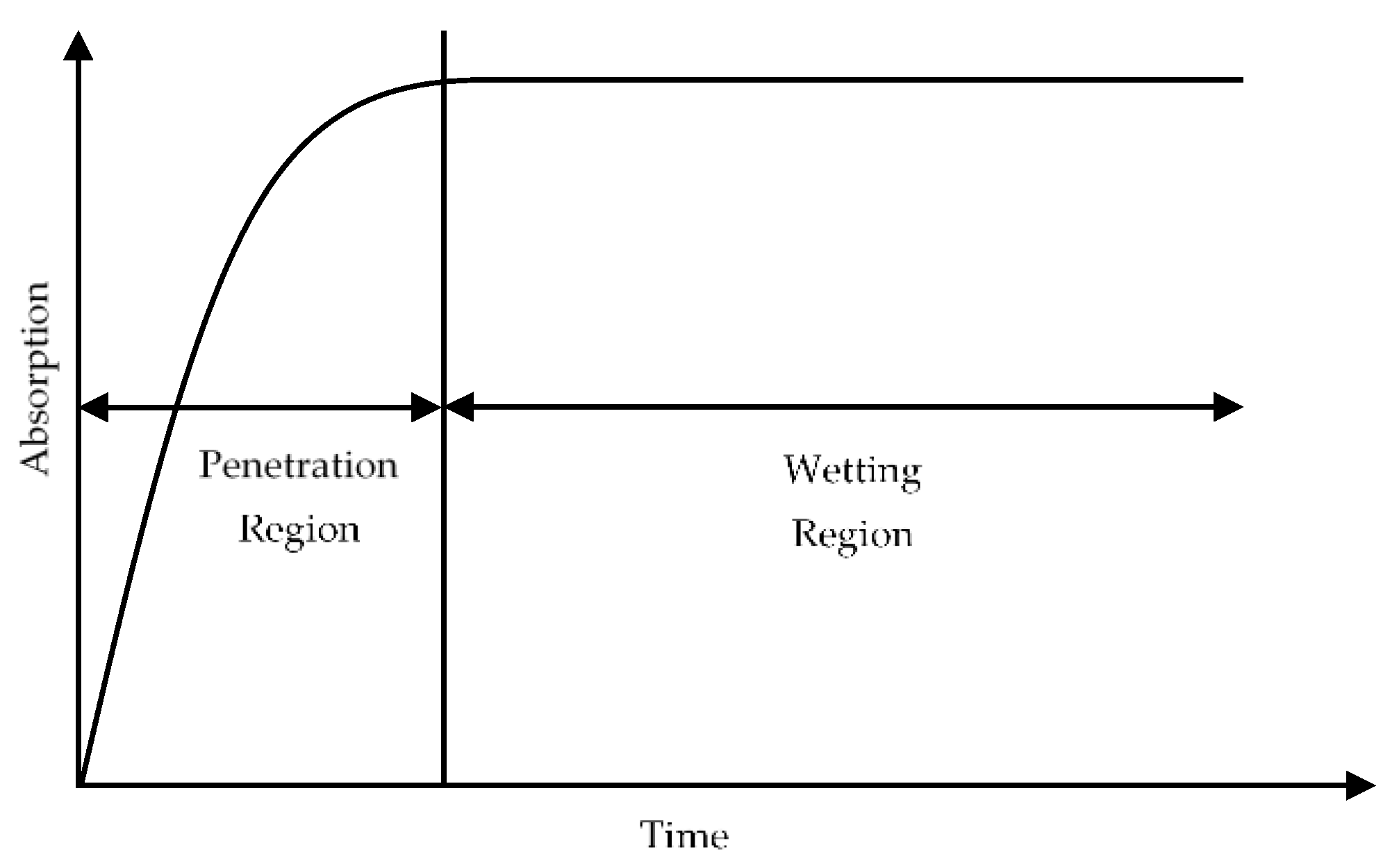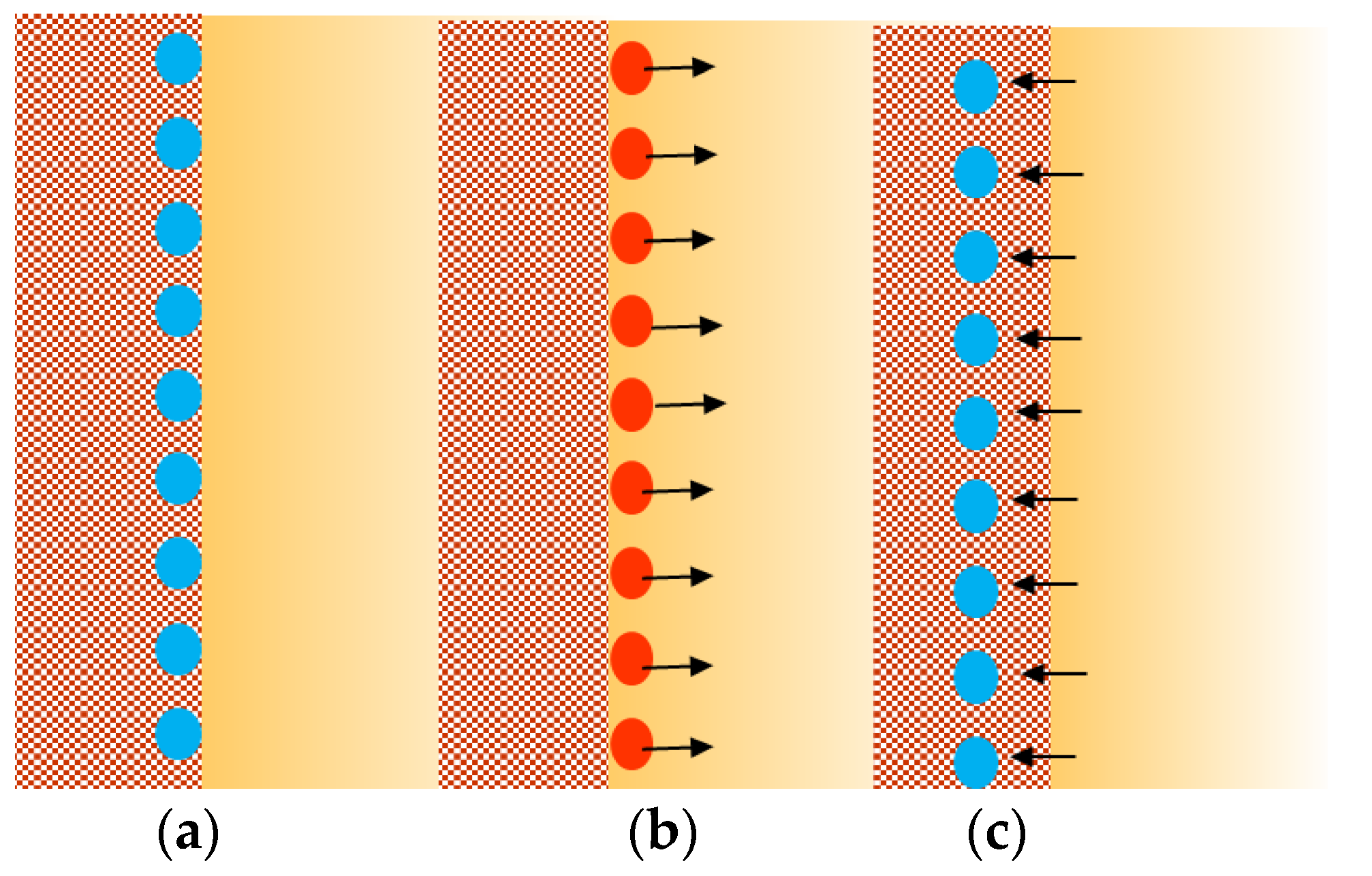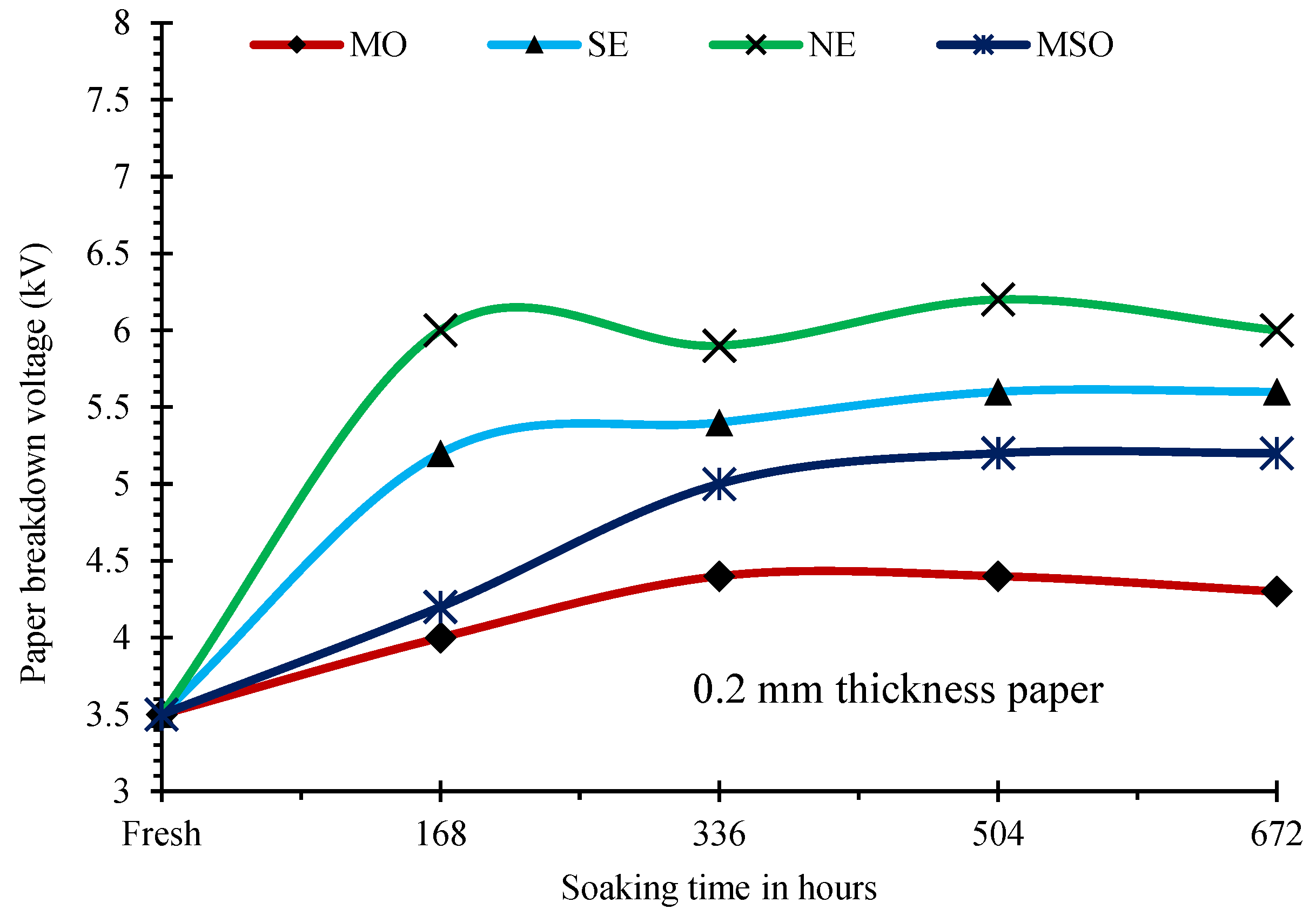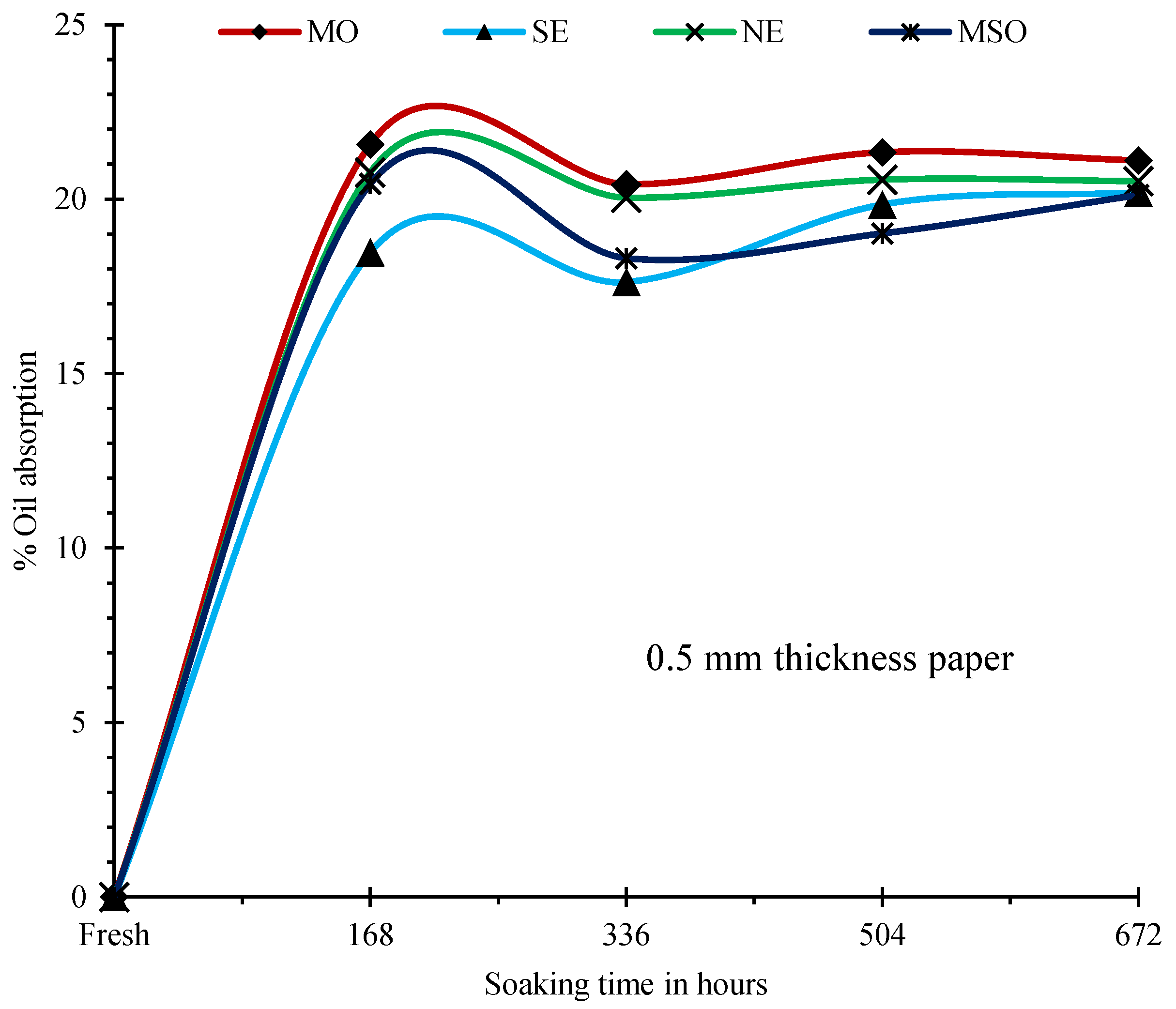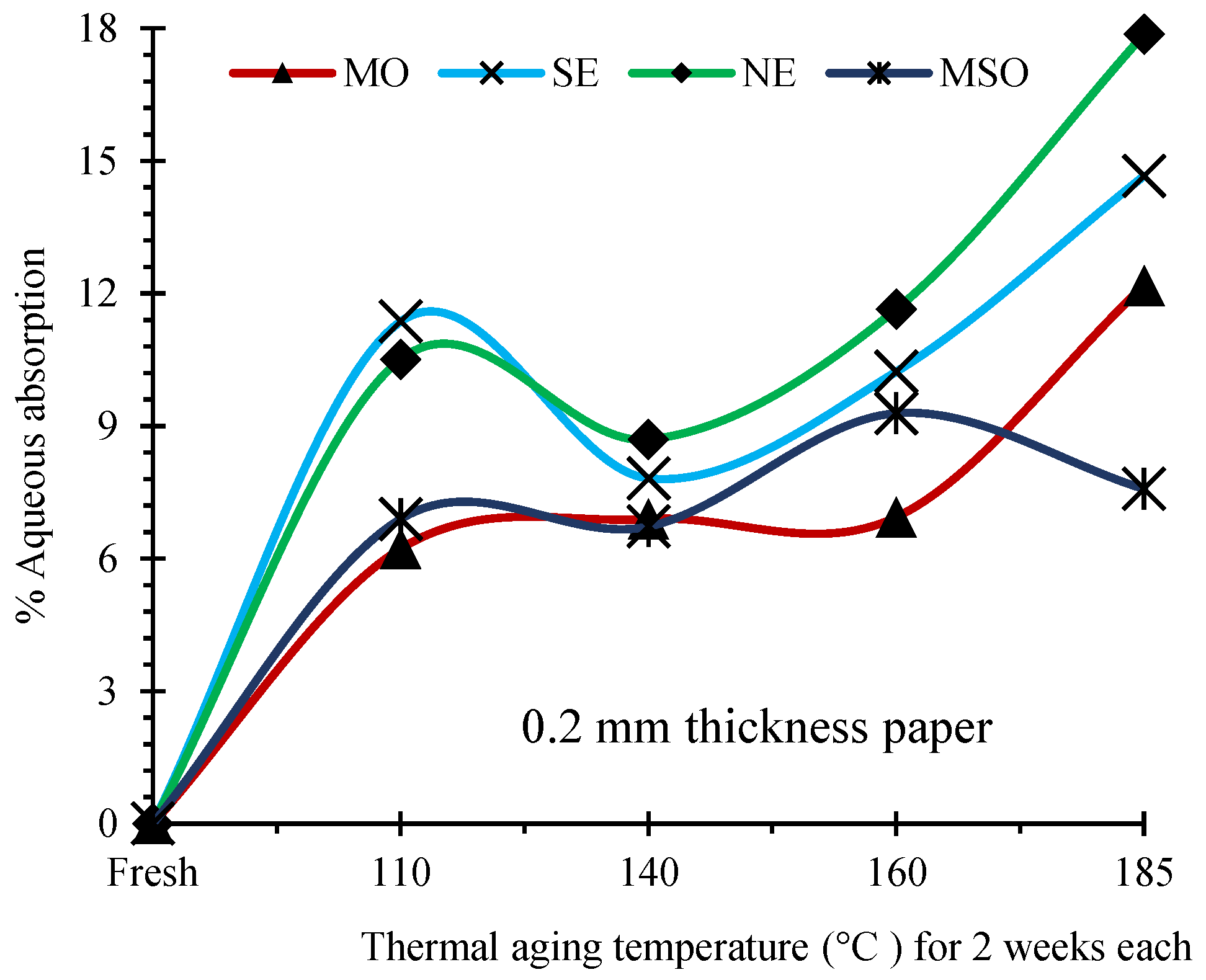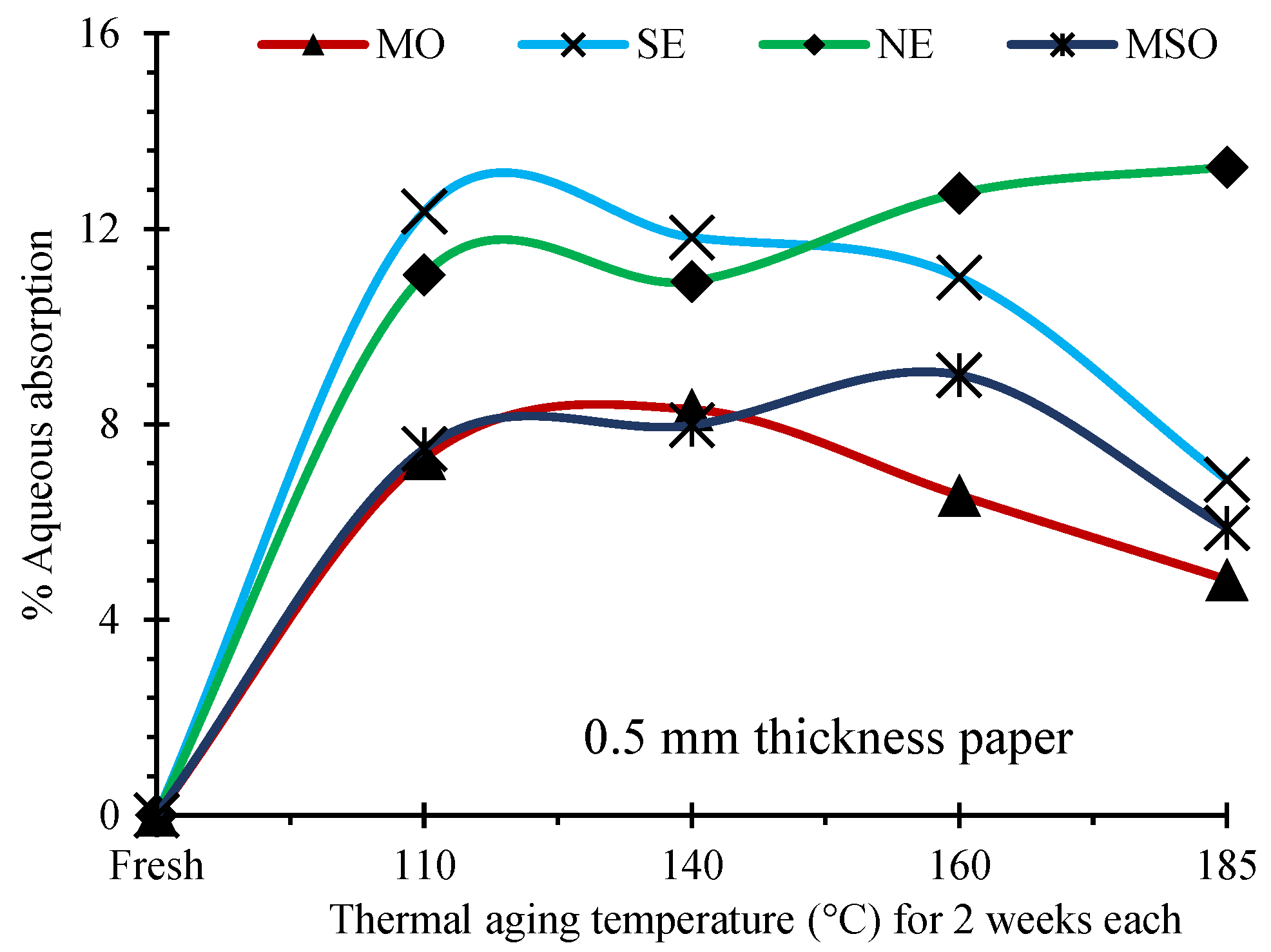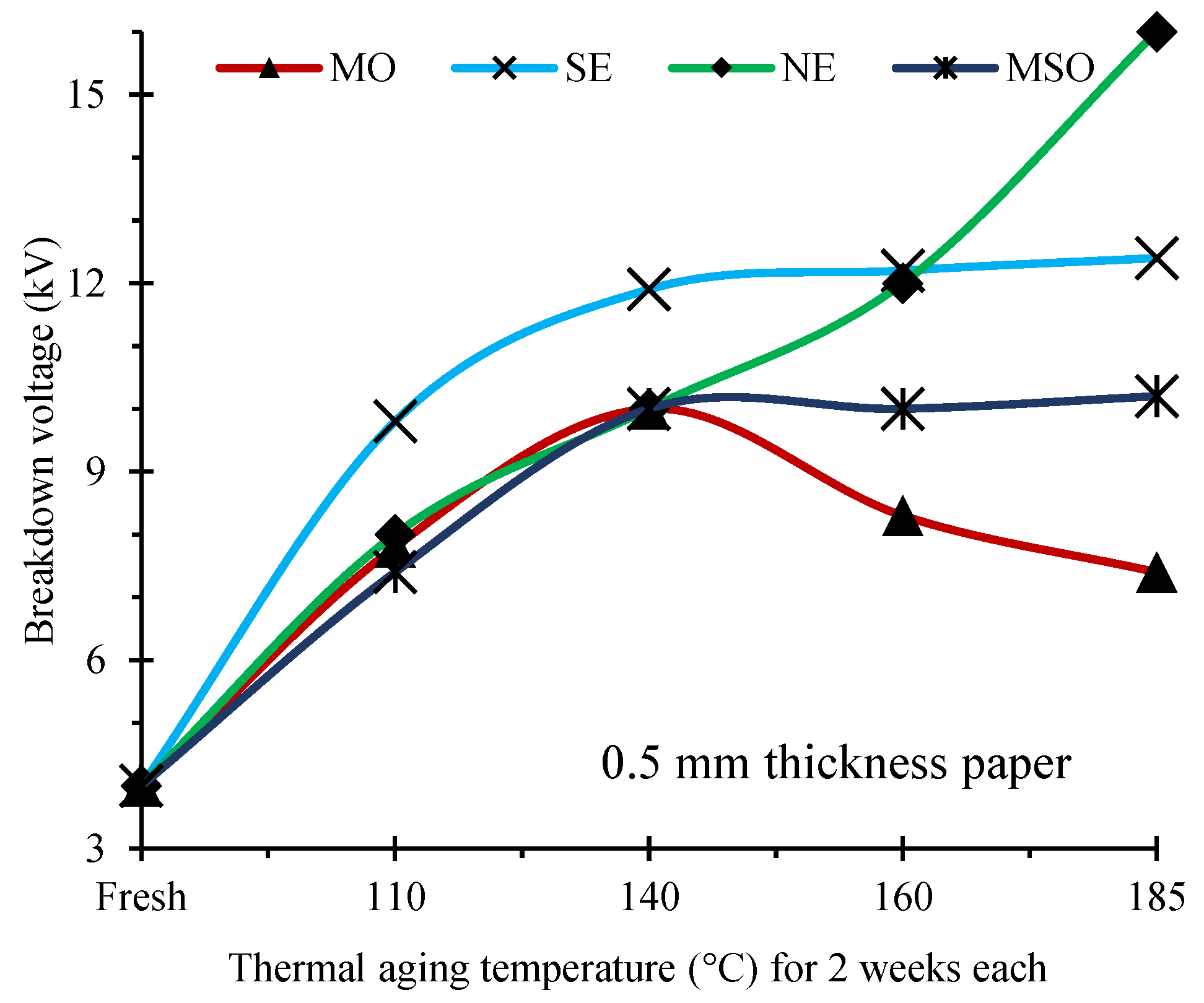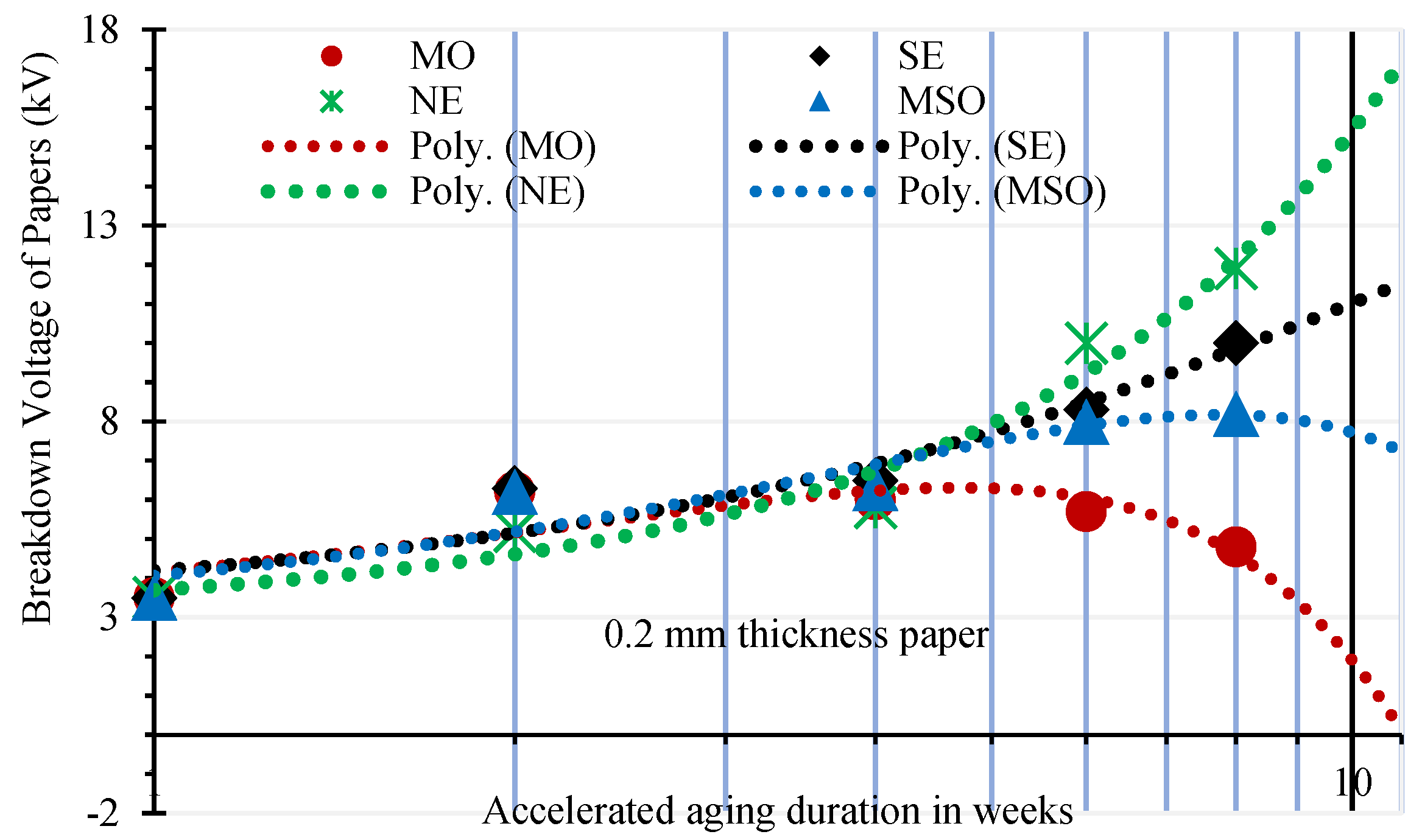1. Introduction
Insulation oil and paper are the main components of a transformer insulation system, which is collectively referred to as oil-paper insulation [
1]. A typical cellulose insulation paper comprises cellulose fibers (rich in count) and less quantity of lignins which are amorphous in nature. Lignins are gums used to bind and hold cellulose fibers together and make the insulation paper hard. The general application of cellulose insulation paper in high voltage electrical equipment follows the dehydration and impregnation process before using it at the point of application [
2].
The aim of dehydration is to remove moisture/water content encapsulated within the amorphous regions or cellulose fibers and reduce the dielectric losses. During the manufacturing of cellulose insulation papers, almost all the manufacturing cycles end up with dehydration procedures. The typical factory dehydration process involves two steps: (i) To move absorbed and bonded moisture from the interior layers of cellulose fibers to the surface (to the solid-air interface). (ii) To migrate moisture adsorbed on the paper’s surface to surround the medium, typically air or vacuum (from the surface to air). Although due care is taken, exposure of cellulose insulation paper to atmospheric air during transportation or handling is unavoidable and thus leads to moisture adsorption on the paper surface. Therefore, it is common to perform dehydration procedures before assembling the transformer parts. It is to be noted that the dehydration process must be accompanied by the removal of moisture without any chemical changes in the cellulose fibers [
3].
Non-impregnated paper, when used for high voltage applications, results in partial discharges and premature insulation breakdown. This is due to the air voids, and the reason for these premature failures is that air breaks at relatively low voltages than those used in the high voltage apparatus. Therefore, the dehydrated cellulose insulants are generally subjected to oil impregnation in order to improve dielectric strength and reduce dielectric losses of paper. This is achieved by replacing the air voids within the dehydrated cellulose insulating paper/pressboard with insulation oil. Generally, the degree of change in the dielectric strength of the paper depends on the efficiency of the replacement process [
2] and the effectiveness of the impregnant to function as a good insulator. This is also attributable to several factors like thickness of paper, the dielectric strength of oil, history of the paper (dehydration and aging conditions), diffusion nature, and viscosity.
It is important to study the behavior of impregnated cellulose paper by considering the operating conditions of high voltage apparatus [
3,
4]. The phenomena of the impregnation process in alternative fluids and impact on paper dielectric strength have been reported in References [
5,
6]. It has been reported that effective impregnation temperature is 60 °C for ester fluids, whereas, for mineral oils, it is 20 °C. In contrast, the influence of other main factors like viscosity and surface tension are similar for mineral oils and ester fluids. It is also reported that the breakdown voltage of the ester impregnated cellulose paper is comparable to that of the mineral oil impregnated paper [
2,
6]. However, moisture evolves with transformer operation times and exhibits a dynamic behavior between oil and paper with temperature changes [
7,
8]. This water forms an aqueous solution with oil and migrates around the oil-paper insulation. Therefore, wetting characteristics of kraft paper are of great concern for oil-paper insulation in large power transformers [
9,
10]. In order to understand the aqueous absorption behavior, the wetting characteristics of cellulose papers in natural esters have been reported in [
11]. The authors reported the penetration and wetting nature of natural esters into cellulose papers. The dynamic and stochastic behavior of oil-moisture will be aggressive with aging times and influence the dielectric strength of the cellulose insulation paper [
12].
The present research is emphasized on the wetting characteristics of cellulose Kraft paper and its influence on paper breakdown voltage. Paper wetting characteristics of two different thickness cellulose papers have been investigated by considering mineral oil and ester fluids as impregnants with and without thermal stress. The wetting behavior with and without thermal stress, change in paper dielectric strength, and the relationship between the aqueous absorption and paper dielectric strength is reported.
2. Wetting Characteristics of Oil/Paper Insulation
Wetting characteristics are the curves that indicate the degree of paper absorption as a function of time [
9,
11]. The wetting properties of oil-paper insulation mainly depend on the absorbing nature of the cellulose fibers. The typical illustration of diffusion behavior of the cellulose paper impregnated by insulation oil is illustrated by the authors in
Figure 1.
When an insulation paper is impregnated, the oil penetrates to the spaces (voids) between the cellulose fibers until an equilibrium is reached between the air pockets and oil [
2]. After this equilibrium stage, the oil will replace all the air pockets in the cellulose insulation paper, and there will be no further space for the oil to penetrate. Up to this stage, the absorbing property of the cellulose fibers plays a major role, and later wetting property of the fibers will accompany the process. Oil diffusion will be rapidly increased in the penetrating region until an equilibrium is reached between the voids and impregnate. Later in the wetting region, the rate of diffusion will be slowly ceased [
10]. In this state, cellulose fibers are completely soaked in the oil, and diffusion in this region will be almost constant for simple impregnation (without moisture dynamics). For diffusion with aging (with moisture dynamics), the rate of diffusion in the wetting region will not be constant and exhibit an osmotic behavior. This osmotic behavior is due to moisture migrations around oil-paper insulation with temperature variations.
Moisture plays a strategic role in the wetting characteristics of the oil-paper insulation system. Moisture could arise from cellulose paper or water vapor present in the surrounding air (for breathing transformer). Moisture partition between oil and paper is assumed to reach a dynamic equilibrium, but practically this assumption will not be achieved because of varying transformer temperatures. Moisture is present in oil at higher temperatures and migrates into paper at lower temperatures [
7,
8]. These migrations of moisture around oil-paper insulation form an aqueous solution with oil. Thus, the oil-moisture mixture aqueous solution will exhibit a dynamic behavior in moving around the oil-paper insulation system [
11]. This dynamic behavior is illustrated in
Figure 2.
Hence, it is to be understood that moisture will be present in the following states in transformers at different conditions
Adsorbed on the large surface of solid insulation [
2].
Form hydrolytic molecular bonds with insulation oil (based on oil chemical composition) [
13].
Absorbed into solid insulation and bonded with cellulose chains [
3].
Emulsified water in oil volume leads to forming an aqueous solution [
11].
Free water molecules at the bottom on the transformer [
13].
Moisture present in all these states has different detrimental impacts on the transformer and exhibits dynamic behavior with temperature. The mathematical expressions for studying diffusion nature are as discussed below.
With aging: Assume Mom is the mass of (moisture adsorbed by paper + moisture dissolved in penetrated oil + oil penetrated into the paper) during the diffusion process.
Let, Wtw be the mass of impregnated cellulose paper at any operating conditions. Wtd is the mass of the dry non-impregnated cellulose insulation paper. Wd represents the loss of paper mass due to thermal degradation.
Now, Wtw = Mom + Wtd − Wd
Wd is very small as compared to Wtd; thus, Wd is ignored.
Now the percentage of aqueous absorption of a paper is calculated as Equation (1).
Without aging: Mathematical expression to determine wetting characteristics without thermal aging is similar to the above case. However, Mom will be replaced by a mass of oil penetrated into the paper (Mo). Moreover, Wd will be absent as the insulation papers are not subjected to thermal stresses.
Mo = mass of oil diffused into paper
Wtw = mass of non-impregnated paper + Mo
Now percentage absorption of a paper as in Equation (2).
3. Experimental and Measurements
For this work, commercially available mineral oil (MO), synthetic ester (SE), natural ester (NE), and a mixture of mineral and synthetic ester oils (MSO) have been considered. To better understand, wetting characteristics are investigated with and without thermal aging for two different thicknesses, 0.2 mm and 0.5 mm cellulose kraft papers. Additionally, the effect of oil diffusion on the dielectric strength of the cellulose insulation papers (with and without degradation) has also been investigated.
With thermal aging: Fresh vacuum degassed (48 h) and dehydrated insulation oils (4 h at 60 °C) have been taken in separate borosilicate glass ampoules. Later, vacuum dehydrated (10 h at 80 °C) cellulose Kraft paper strips of 0.2 mm thickness and 0.5 mm thickness are dipped in each ampoule containing insulating oils. Then, ampoules containing oil-paper insulation were placed in an air circulating oven (M/s. HMG) for thermal aging at 110 °C, 140 °C, 160 °C, and 185 °C for two weeks each. Accelerated aging temperatures were considered with a four-point aging mechanism as per IEEE-C57.100 [
14]. The aging procedure is carried out per modified ASTM D1934 [
15] without metal catalyst. After every test temperature, ampoules are cooled down to room temperature and are transferred to the environmental chamber. Kraft paper strips of 0.2 mm thickness and 0.5 mm thickness are taken out in a dry nitrogen environment to analyze the paper’s aqueous absorption and dielectric strength. It is to be mentioned that the surface of the kraft paper strips is wiped off quickly with hexane wipes to degrease the paper surface before bringing to the analysis.
Without Thermal Aging: Dehydrated insulation oils are taken in separate glass ampoules. Later, strips of 0.2 mm thickness and strips of 0.5 mm thickness are soaked in each ampoule containing insulating oils at room temperature and pressure in an environmental chamber. Then, ampoules containing oil-paper insulation were placed at room temperature (22 ± 3 °C) for 4 weeks. A strip of each thickness is drained every week to analyze aqueous absorption and corresponding dielectric strength. The surface of the kraft paper strips is wiped off quickly with hexane to degrease the paper surface before bringing to the analysis. To understand the diffusion behavior clearly, a soaking period of one week is adopted such that the diffusion nature is observed in both the penetration region and wetting region. All dry kraft paper strips’ weights and dielectric strength are recorded to establish a baseline.
The weight of cellulose insulation paper is measured using a high precision electronic balance (M/s. OHAUS). Breakdown voltage (BDV) measurement (lab scale) of paper is carried out as per ASTM D149-09 [
16] standard test procedure by adopting cylindrical electrodes. Paper BDV is measured at four different places. The average values used for analysis. For illustration purposes, the average (M), standard deviation (SD), and standard error (SE) values of BDV measurements for 0.5 mm thickness paper with aging are presented in
Table 1.
4. Observations and Inferences
4.1. Wetting Characteristics without Thermal Aging and Change in Paper BDV
This section discusses the wetting characteristics of oil-paper insulation with mineral oil, synthetic ester, natural ester, and mixture of mineral and synthetic ester without thermal stressing oils. Diffusion behavior and paper dielectric strength of different oil-paper insulation systems were investigated by impregnating cellulose insulation papers using a simple soaking method at room temperature. As discussed earlier, Kraft paper samples were allowed to be impregnated by different insulating oils in different glass ampoules for a continuous period of 4 weeks. After every week, paper samples were drained to analyze absorption and variation in the dielectric strength of the cellulose insulation papers of 0.2 mm thickness and 0.5 mm thickness in various insulating oils. This is illustrated as a function of soaking time in
Figure 3,
Figure 4,
Figure 5 and
Figure 6.
It is observed from
Figure 3,
Figure 4 and
Figure 5 that diffusion nature exhibited a substantial rise initially in the penetration region. This is due to the replacement of air in cellulose capillaries and voids with insulation oil. Rapid penetration of impregnant into the paper ceases when the oil and the air pockets are in equilibrium, i.e., all the air pockets are replaced by the impregnant. Later, this penetration will be ceased slowly, and the diffusion process is said to be in the wetting region. This is because; cellulose fibers will become wet by the surrounding insulation oil in this region. The penetration of oil into paper in this region will be almost constant. Different insulating oils have different degrees of penetration into paper, accompanied by the corresponding change in the dielectric strength of the paper. It is to be noticed that mineral oil and natural ester have a high penetration rate compared to mixed oil and synthetic esters. This nature is mainly attributable to the impregnants’ contact angle and surface tension [
10]. Moreover, the curves show a small maximum at the peaks for
Figure 3 and
Figure 5. It was also observed that the degree of diffusion is increased with an increase in the thickness of insulation paper. This is because thick papers have a high density of cellulose fibers and subsequently higher oil absorption.
The main objective of insulation paper impregnation by oil is to increase the dielectric strength of the insulation paper. It is noticed from
Figure 3,
Figure 4,
Figure 5 and
Figure 6 that natural ester impregnated paper exhibits a higher dielectric strength amongst all the papers for both 0.2 mm and 0.5 mm thickness paper. Synthetic esters and mixed oil-impregnated papers have high dielectric strength than paper impregnated by mineral oil. It is observed that the dielectric strength of the paper impregnated in ester (natural and synthetic) liquids and mixed oil are substantially improved when compared to mineral oils. Even though this rapid increase in paper BDV is based on the dielectric strength of the impregnant, the efficiency of replacement of air with oil is also a governing factor [
2,
6]. The dielectric strength of ester fluids is higher than the mineral insulating oils, and hence, papers impregnated by esters have higher dielectric strength. It is to be noted that these observations were based on mere soaking at room temperature and pressure where the effects of temperature, moisture, and degradation of cellulose fibers were not considered. Impregnation temperatures and vacuum conditions were not considered as the objectives of this study were not emphasized on the impregnation process. The impregnation process for different thickness papers and pressboards was reported in [
5]. The diffusion and wetting process while simulating the aging conditions are discussed in subsequent sections.
4.2. Wetting Characteristics with Thermal Aging and Change in Paper BDV
Thermal aging is performed to consider the effect of temperature, moisture, and degradation of cellulose fibers in understanding the diffusion behavior and effect on paper dielectric strength. The changes in percentage aqueous absorption (oil-moisture mixture) and the corresponding change in the dielectric strength of the cellulose insulation paper samples in various insulating oils are illustrated as a function of test temperature in
Figure 7,
Figure 8,
Figure 9 and
Figure 10.
4.3. Influence of the Cellulose Thickness
The wetting characteristics and corresponding changes in breakdown voltage of 0.2 mm thickness paper with aging are shown in
Figure 7 and
Figure 8. In the penetrating region, synthetic and natural esters are found better, and mixed oil is better than mineral oil in terms of oil diffusion. However, in the penetration region, diffusion increases linearly for all the oils because the cellulose voids and capillaries absorb the oil. In the wetting region, the diffusion is stochastic in nature, which is attributable to moisture migrations within the oil-paper insulation with temperature variations. This stochastic nature is accompanied by osmotic and reverse osmotic diffusion of insulation oils. The diffusion process may also be attributed to the density of the oils and contact angle of the oils with insulation paper. However, it was observed that the oil-absorbing nature of the papers was reduced as the space required for accommodating the aqueous solution in the paper was reduced gradually. The breakdown voltage of papers impregnated in synthetic and natural esters is found to be better in the penetration region and the wetting region.
The wetting characteristics and corresponding changes in breakdown voltage of 0.5 mm thickness paper with aging are shown in
Figure 9 and
Figure 10. It is observed that synthetic and natural esters are better in terms of oil diffusion. In the wetting region, the diffusion nature is found to exhibit stochastic nature with osmotic and reverse osmotic diffusion of insulation oils. It is also observed that the rate of diffusion is reduced in all the oils given the equilibrium between air pockets and oil penetrated. The breakdown voltage of the papers impregnated and aged in synthetic ester is better when compared to papers impregnated by other insulating oils. However, the BDV of paper impregnated and aged in natural esters performed well at higher temperatures as the oil diffusion in this region is also improved for natural esters [
17].
When oil-to-oil is compared with thermal aging, synthetic esters are found to penetrate into the insulation paper at higher rates when compared to other insulating oils. When paper-to-paper is compared, it is found that the rate of diffusion is better for 0.5 mm thickness paper impregnated in synthetic esters. The maximum diffusion obtained is different for different types of oils and different cellulose thicknesses at different aging factors. Hence, it is inferred that diffusion is attributed to the type of oil, degree of aging of oil-paper insulation, and thickness of the paper. It is also inferred that; diffusion of oil is directly related to the thickness of insulation paper, and BDV of papers varied in accordance with the aging conditions and diffusion. This variation in the dielectric strength of cellulose insulation paper mainly depends on the quality of the impregnant. If the impregnant is dry and free from moisture with high dielectric strength, the impregnation process will be accompanied by a substantial rise in the dielectric strength of paper and vice versa. Nevertheless, in transformers, the quality of the oil deteriorates with age owing to moisture, oxidation products, and contamination which leads to a reduction in oil dielectric strength [
2,
6,
17]. Moisture developed remains in oil at high temperature and migrates to insulation paper at a lower temperature, concluding the moisture migrations around the insulation paper.
Additionally, the quality of the cellulose paper in transformers also reduces with aging due to high thermal excursions and moisture migrations [
2]. These moisture migrations lead the diffusion process to an osmatic and reverse osmatic nature in the wetting region. Moisture is adsorbed physically on the paper’s surface and settles in the cellulose capillaries resulting in the formation of weak bonds through hydroxyl groups of the cellulose fiber [
17]. These bonds were formed at lower temperatures and are deformed at higher temperatures [
2]. This is the primary reason for the moisture to migrate into oil at higher temperatures.
4.4. Expectancy of Paper Dielectric Strength with Aging
Changes in the dielectric strength of different thickness insulation papers are investigated with oil-moisture absorption at different aging factors. Owing to moisture migrations, the dynamic equilibrium between the oil and paper ceases, leading to detrimental causes. However, it is to be noted that the dielectric strength of the papers will remain rich if the quality of insulation oil and cellulose fibers is effective. In oil-filled transformers, degradation of the cellulose fibers and insulation oil is an irreversible process in which oil degradation is more rapid than insulation paper [
2,
17]. The dielectric strength of paper is highly influenced by the aging by-products of the oil [
18]. Hence, the dielectric strength of the paper increases to a certain level, and later, it starts reducing with an increase in oil degradation by-products, moisture migrations, and degradation of cellulose fibers. The degree of oil degradation in the present study is understood by the UV/Vis spectroscopy (M/s. Agilent, ASTM D6802, Santa Clara, CA, USA) and is presented the
Figure 11. It was observed that mineral oil was highly degraded with a high concentration of dissolved decay products compared to the ester fluids that were less degraded. Therefore, the BDV of paper aged in mineral oil decreases compared to other fluids. The hydrophilic nature of the ester group consumes more water in the hydrolysis process and keeps the paper dry [
19]. The hydrophobic nature of mineral oil provides scope for more water and develops excess sludging in oil [
2,
20].
This reduction in paper dielectric strength with aging is observed for cellulose insulation paper impregnated and aged in mineral insulating oils. Dielectric strength prediction is carried out for both 0.2 mm thickness and 0.5 mm thickness paper samples by adopting a semi-logarithmic plotting to further understand this process. The expectance of paper dielectric strength as a function of stress duration beyond aging duration is extrapolated and is shown in
Figure 12 and
Figure 13.
Breakdown voltage extrapolation is presented to a limit until the duration where the dielectric strength of the cellulose insulation paper aged in mineral oil reaches 0 kV. Such that the performance of paper breakdown voltage in mineral oil may be compared with paper breakdown voltages in ester oils (natural and synthetic) and mixed oil. It was observed from the paper BDV expectancy curves that cellulose insulation paper impregnated and aged in mineral oil reaches 0 kV at a lesser time than those impregnated and aged in synthetic ester, natural ester, and mixed oil. It is seen that BDV of NE is increasing with aging. This will not indicate that paper BDV in ester fluids increases with aging. This incremental property is due to extrapolating the NE experimental data, which has not shown any decrease in paper BDV. To see the reduction in paper BDV with ester fluids, one may look at the further aging factors. However, with 0.5 mm thickness paper, the reduction in paper BDV in SE is noted. Hence, considering the dielectric strength of the insulation paper, it is inferred that oil-paper insulation associated with mineral insulation oil is inferior to that of the oil-paper insulation associated with ester and mixed oils.
4.5. Relation between Diffusion Behavior and Paper BDV with Aging
The present work performed correlation analysis by using Origin 8.5 software for curve fitting and regression analysis of the data set obtained experimentally. The wetting characteristics had a significant effect on the dielectric breakdown voltage of the paper. Hence, correlation analysis was performed to observe the effect of diffusion on the dielectric breakdown of insulation paper aged in the presence of mineral oil, synthetic ester, natural ester, and mixed oil. Linear regression analysis was carried out between aqueous absorption into paper and the breakdown voltage of insulating paper. It was observed that linear curve fitting of data was poor for MO, SE, and MSO oil/paper insulation systems. Hence, a second-order polynomial model was utilized to improve the curve fitting. Curve fitting and, hence, coefficient of determination was improved with the second-order polynomial model. Polynomial regression plots are shown in
Figure 14 and
Figure 15 for 0.2 mm thickness and 0.5 mm thickness Kraft paper, respectively. It is to be noted that (a), (b), (c), and (d) subplots in
Figure 14 and
Figure 15 indicate different insulating liquids MO, SE, Ne, and MSO respectively.
However, in the case of natural ester, linear fitting was better, indicating the linear relationship between diffusion nature and breakdown strength of paper for natural ester filled transformer. Whereas in MO, SE, and MSO, polynomial fitting was found to be better, indicating the breakdown voltage of paper varies polynomially with oil/moisture diffusion.
5. Conclusions
This paper reports the diffusion nature of different insulating oils with different thickness cellulose insulation papers. The effect of oil absorption on the dielectric strength of the paper has been studied. The variation in the dielectric strength of the papers with wetting and thermal aging has also been reported. It is found that ester fluids diffuse at a higher rate, accompanied by a significant improvement in the paper BDV when compared to the mineral insulating oil. It is also verified that; oil diffusion is a function of the moisture and depends on the type of insulation oil and thickness of insulation paper. Furthermore, correlation analysis between diffusion and paper dielectric strength is studied with thermal aging. Moreover, the dielectric strength performance of paper aged in mineral oil is inferior to that of the ester dielectric fluids. Further investigation may focus on the influence of tensile strength and cellulose polymerization degree on the wetting characteristics.
Author Contributions
Conceptualization, U.M.R.; methodology, G.T.N. and U.M.R.; formal analysis, G.T.N. and U.M.R.; investigation, G.T.N. and U.M.R.; writing—original draft preparation, G.T.N. and U.M.R.; writing—review and editing, U.M.R.; visualization, S.S.; supervision, U.M.R. and S.S. All authors have read and agreed to the published version of the manuscript.
Funding
This research received no external funding.
Institutional Review Board Statement
Not applicable.
Informed Consent Statement
Not applicable.
Data Availability Statement
Not applicable.
Conflicts of Interest
The authors declare no conflict of interest.
References
- Rozga, P.; Stanek, M. Characteristics of streamers developing at inception voltage in small gaps of natural ester, synthetic ester and mineral oil under lightning impulse. IET Sci. Meas. Technol. 2015, 10, 50–57. [Google Scholar] [CrossRef]
- Rao, U.M.; Fofana, I.; Jaya, T.; Rodriguez-Celis, E.M.; Jalbert, J.; Picher, P. Alternative dielectric fluids for transformer insulation system: Progress, challenges, and future prospects. IEEE Access 2019, 7, 184552–184571. [Google Scholar]
- Pompili, M.; Mazzetti, C.; Bartnikas, R. Comparative PD pulse burst characteristics of transformer type natural and synthetic ester fluids and mineral oils. IEEE Trans. Dielectr. Electr. Insul. 2009, 16, 1511–1518. [Google Scholar] [CrossRef]
- Li, J.; Zhang, J.; Wang, F.; Huang, Z.; Zhou, Q. A novel aging indicator of transformer paper insulation based on dispersion staining colors of cellulose fibers in oil. IEEE Electr. Insul. Mag. 2018, 34, 8–16. [Google Scholar] [CrossRef]
- Dai, J.; Wang, Z.D. A comparison of the impregnation of cellulose insulation by ester and mineral oil. IEEE Trans. Dielectr. Electr. Insul. 2008, 15, 374–381. [Google Scholar] [CrossRef]
- Dielectric Performance of Insulating Liquids for Transformers; TB 856, WG D1.70, TF 3; CIGRE: Paris, France, 2021.
- Martin, D.; Saha, T.; Gray, T.; Wyper, K. Determining water in transformer paper insulation: Effect of measuring oil water activity at two different locations. IEEE Electr. Insul. Mag. 2015, 31, 18–25. [Google Scholar] [CrossRef]
- Martin, D.; Saha, T.; Dee, R.; Buckley, G.; Chinnarajan, S.; Caldwell, G.; Zhou, J.B.; Russell, G. Determining water in transformer paper insulation: Analyzing ageing transformers. IEEE Electr. Insul. Mag. 2015, 31, 23–32. [Google Scholar] [CrossRef]
- Reffas, A.; Moulai, H.; Beroual, A. Creeping discharges propagating on natural ester oils/pressboard interface under AC and lightning impulse voltages. IEEE Trans. Dielectr. Electr. Insul. 2018, 25, 1814–1821. [Google Scholar] [CrossRef]
- Hubbe, M.A. Paper wetting and penetration of liquids. Encycl. Mater. Sci. Technol. 2001, 6735–6739. [Google Scholar] [CrossRef]
- Suleiman, A.A.; Nazri, F.; Muhamad, N.A.; Bashir, N.; Mohamad, Z. Wetting characteristics for kraft paper immersed in mineral and biodegradable insulation oils. In Proceedings of the 2014 IEEE 8th International Power Engineering and Optimization Conference (PEOCO2014), Langkawi, Malaysia, 24–25 March 2014; pp. 194–198. [Google Scholar]
- Przybylek, P.; Gielniak, J. Analysis of Gas Generated in Mineral Oil, Synthetic Ester, and Natural Ester as a Consequence of Thermal Faults. IEEE Access 2019, 7, 65040–65051. [Google Scholar] [CrossRef]
- Fofana, I.; Arakelian, V.G. Water in oil-filled high-voltage equipment, Part I: States, solubility, and equilibrium in insulating materials. IEEE Electr. Insul. Mag. 2007, 23, 15–27. [Google Scholar]
- C57.100Standard Test Procedure for Thermal Evaluation of Insulation Systems for Liquid-Immersed Distribution and Power Transformers, IEEE: New York, NY, USA, 2012.
- ASTM D1934Standard Test Method for Oxidative Aging of Electrical Insulating Petroleum Oils by Open-Beaker Method, ASTM: West Conshohocken, PA, USA, 2012.
- ASTM D 149–09Standard Test Method for Dielectric Breakdown Voltage and Dielectric Strength of Solid Electrical Insulating Materials at Commercial Power Frequencies, ASTM: West Conshohocken, PA, USA, 2013.
- Ghani, S.A.; Muhamad, N.A.; Noorden, Z.A.; Zainuddin, H.; Bakar, N.A.; Talib, M.A. Methods for improving the workability of natural ester insulating oils in power transformer applications: A review. Electr. Power Syst. Res. 2018, 163, 655–667. [Google Scholar] [CrossRef]
- Hadjadj, Y.; Fofana, I.; Sabau, J.; Briosso, E. Assessing insulating oil degradation by means of turbidity and UV/VIS spectrophotometry measurements. IEEE Trans. Dielectr. Electr. Insul. 2015, 22, 2653–2660. [Google Scholar] [CrossRef]
- Xiang, J.; Li, J.; Zhang, Z. Influence of water content on the aging performance of natural ester-paper insulation. In Proceedings of the 2012 International Conference on High Voltage Engineering and Application, Shanghai, China, 17–20 September 2012; pp. 663–666. [Google Scholar]
- Jacob, J.; Preetha, P.; Sindhu, T.K. Stability analysis and characterization of natural ester nanofluids for transformers. IEEE Trans. Dielectr. Electr. Insul. 2020, 27, 1715–1723. [Google Scholar] [CrossRef]
Figure 1.
Wetting characteristics of a typical cellulose insulation paper.
Figure 1.
Wetting characteristics of a typical cellulose insulation paper.
Figure 2.
(a) Moisture adsorption on the paper surface; (b) Diffusion of oil/moisture aqueous solution into the paper at low temperatures; (c) Moisture migration into oil at higher temperatures.
Figure 2.
(a) Moisture adsorption on the paper surface; (b) Diffusion of oil/moisture aqueous solution into the paper at low temperatures; (c) Moisture migration into oil at higher temperatures.
Figure 3.
Wetting characteristics of 0.2 mm thickness papers without thermal stressing in various insulating oils.
Figure 3.
Wetting characteristics of 0.2 mm thickness papers without thermal stressing in various insulating oils.
Figure 4.
Change in paper BDV with the diffusion of various insulating oils for 0.2 mm thickness papers without thermal stresses.
Figure 4.
Change in paper BDV with the diffusion of various insulating oils for 0.2 mm thickness papers without thermal stresses.
Figure 5.
Wetting characteristics of 0.5 mm thickness papers without thermal stressing in various insulating.
Figure 5.
Wetting characteristics of 0.5 mm thickness papers without thermal stressing in various insulating.
Figure 6.
Change in paper BDV with the diffusion of various insulating oils for 0.5 mm thickness papers without thermal stresses oils.
Figure 6.
Change in paper BDV with the diffusion of various insulating oils for 0.5 mm thickness papers without thermal stresses oils.
Figure 7.
Wetting characteristics of 0.2 mm thickness papers with thermal stressing in various insulating oils.
Figure 7.
Wetting characteristics of 0.2 mm thickness papers with thermal stressing in various insulating oils.
Figure 8.
Change in paper BDV with the diffusion of various insulating oils for 0.2 mm thickness papers with thermal stresses.
Figure 8.
Change in paper BDV with the diffusion of various insulating oils for 0.2 mm thickness papers with thermal stresses.
Figure 9.
Wetting characteristics of 0.5 mm thickness papers with thermal stressing in various insulating oils.
Figure 9.
Wetting characteristics of 0.5 mm thickness papers with thermal stressing in various insulating oils.
Figure 10.
Change in paper BDV with the diffusion of various insulating oils for 0.5 mm thickness papers with thermal stresses.
Figure 10.
Change in paper BDV with the diffusion of various insulating oils for 0.5 mm thickness papers with thermal stresses.
Figure 11.
UV Spectral curves of oils indicate the degree of degradation.
Figure 11.
UV Spectral curves of oils indicate the degree of degradation.
Figure 12.
Expectance of BDV for 0.2 mm thickness paper with the diffusion of various insulating oils with thermal stressing.
Figure 12.
Expectance of BDV for 0.2 mm thickness paper with the diffusion of various insulating oils with thermal stressing.
Figure 13.
Expectance of BDV for 0.5 mm thickness paper with the diffusion of various insulating oils with thermal stressing.
Figure 13.
Expectance of BDV for 0.5 mm thickness paper with the diffusion of various insulating oils with thermal stressing.
Figure 14.
Regression plots for 0.2 mm thickness paper in various insulating oils. (a) Insulating liquid MO, (b) Insulating liquid SE, (c) Insulating liquid Ne, and (d) Insulating liquid MSO.
Figure 14.
Regression plots for 0.2 mm thickness paper in various insulating oils. (a) Insulating liquid MO, (b) Insulating liquid SE, (c) Insulating liquid Ne, and (d) Insulating liquid MSO.
Figure 15.
Regression plots for 0.5 mm thickness paper in various insulating oils. (a) Insulating liquid MO, (b) Insulating liquid SE, (c) Insulating liquid Ne, and (d) Insulating liquid MSO.
Figure 15.
Regression plots for 0.5 mm thickness paper in various insulating oils. (a) Insulating liquid MO, (b) Insulating liquid SE, (c) Insulating liquid Ne, and (d) Insulating liquid MSO.
Table 1.
Statistical analysis of BDV for 0.5 mm thickness paper with aging.
Table 1.
Statistical analysis of BDV for 0.5 mm thickness paper with aging.
| | | MO | SE | NE | MSO |
|---|
| Fresh | M | 4 |
| SD | 0.21 |
| SE | 0.1 |
| 110 | M | 7.8 | 9.8 | 8 | 7.45 |
| SE | 0.51 | 0.53 | 0.40 | 0.41 |
| SE | 0.25 | 0.3 | 0.2 | 0.2 |
| 140 | M | 10 | 11.82 | 10 | 10 |
| SD | 2.4 | 1.0 | 2.6 | 2.2 |
| SE | 1.24 | 0.54 | 1.30 | 1.13 |
| 160 | M | 8.3 | 12.2 | 12 | 10 |
| SD | 0.52 | 0.53 | 0.90 | 0.90 |
| SE | 0.26 | 0.26 | 0.45 | 0.45 |
| 185 | M | 7.4 | 12.4 | 16 | 10.2 |
| SD | 0.5 | 0.91 | 0.81 | 0.67 |
| SE | 0.2 | 0.45 | 0.40 | 0.33 |
| Publisher’s Note: MDPI stays neutral with regard to jurisdictional claims in published maps and institutional affiliations. |
© 2022 by the authors. Licensee MDPI, Basel, Switzerland. This article is an open access article distributed under the terms and conditions of the Creative Commons Attribution (CC BY) license (https://creativecommons.org/licenses/by/4.0/).
